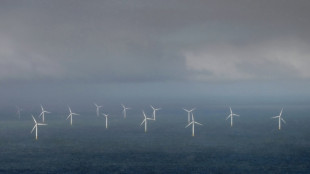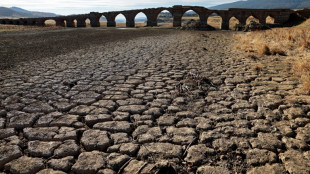
-
 UN chief promises to do "everything" to avoid food cuts to Rohingyas in Bangladesh
UN chief promises to do "everything" to avoid food cuts to Rohingyas in Bangladesh
-
UniCredit gets ECB nod on Commerzbank stake, but delays merger decision

-
 Sri Lanka adjusts train timings to tackle elephant deaths
Sri Lanka adjusts train timings to tackle elephant deaths
-
BMW expects big hit from tariffs after 2024 profits plunge

-
 Gold tops $3,000 for first time on Trump tariff threats
Gold tops $3,000 for first time on Trump tariff threats
-
UK energy minister heads to China to talk climate

-
 Syrian Druze cross armistice line for pilgrimage to Israel
Syrian Druze cross armistice line for pilgrimage to Israel
-
UN chief in Rohingya refugee camp solidarity visit

-
 Taiwan tech giant Foxconn's 2024 profit misses forecasts
Taiwan tech giant Foxconn's 2024 profit misses forecasts
-
UniCredit gets ECB nod for Commerzbank stake

-
 BMW warns on tariffs, China as 2024 profits plunge
BMW warns on tariffs, China as 2024 profits plunge
-
Driving ban puts brakes on young women in Turkmenistan

-
 Stargazers marvel at 'Blood Moon', rare total lunar eclipse
Stargazers marvel at 'Blood Moon', rare total lunar eclipse
-
Peaceful Czechs grapple with youth violence

-
 From oil spills to new species: how tech reveals the ocean
From oil spills to new species: how tech reveals the ocean
-
Former sex worker records Tokyo's red-light history

-
 Most Asian markets rise on hopes for bill to avert US shutdown
Most Asian markets rise on hopes for bill to avert US shutdown
-
Renowned US health research hub Johns Hopkins to slash 2,000 jobs

-
 You're kidding! Prince William reveals Aston Villa superstitions
You're kidding! Prince William reveals Aston Villa superstitions
-
Top US university says ending 2,000 positions due to Trump cuts

-
 Stock markets tumble as Trump targets booze
Stock markets tumble as Trump targets booze
-
Sea levels rise by 'unexpected' amount in 2024: NASA

-
 Trump tariff threat leaves sour taste for European drinks producers
Trump tariff threat leaves sour taste for European drinks producers
-
Ex-NOAA chief: Trump firings put lives, jobs, and science in jeopardy

-
 Spain to face increasingly 'severe' droughts: report
Spain to face increasingly 'severe' droughts: report
-
Georgian designer Demna leaves Balenciaga for Gucci

-
 Diet puts Greenland Inuit at risk from 'forever chemicals': study
Diet puts Greenland Inuit at risk from 'forever chemicals': study
-
'Blood Moon' rising: Rare total lunar eclipse tonight

-
 Donatella Versace, fashion icon who saved slain brother's brand
Donatella Versace, fashion icon who saved slain brother's brand
-
Sweden to hold talks on countering soaring food costs

-
 Asteroid probe snaps rare pics of Martian moon
Asteroid probe snaps rare pics of Martian moon
-
EU, US eye greater energy ties amid Trump frictions

-
 Donatella Versace to give up creative reins of brand after 28 years
Donatella Versace to give up creative reins of brand after 28 years
-
Stock markets find little cheer as Trump targets champagne

-
 UK seeks tougher term for father jailed over daughter's murder
UK seeks tougher term for father jailed over daughter's murder
-
Kyrgyzstan, Tajikistan sign border deal to boost regional stability

-
 First brown bear to have brain surgery emerges from hibernation
First brown bear to have brain surgery emerges from hibernation
-
Iraq says seeking alternatives to Iran gas

-
 Food app Deliveroo delivers first annual profit
Food app Deliveroo delivers first annual profit
-
Less mapped than the Moon: quest to reveal the seabed

-
 Couche-Tard bosses make case in Tokyo for 7-Eleven buyout
Couche-Tard bosses make case in Tokyo for 7-Eleven buyout
-
Australia tells US influencer: 'leave baby wombat alone'

-
 'Sound science' must guide deep-sea mining: top official
'Sound science' must guide deep-sea mining: top official
-
Asian stocks wobble as US inflation fails to ease trade worries

-
 Trump's Canada fixation: an expansionist dream
Trump's Canada fixation: an expansionist dream
-
Generative AI rivals racing to the future

-
 DeepSeek dims shine of AI stars
DeepSeek dims shine of AI stars
-
Americas to witness rare 'Blood Moon' total lunar eclipse

-
 More wait for stranded astronauts after replacement crew delayed
More wait for stranded astronauts after replacement crew delayed
-
Argentine football fans, protesters clash with police at pensions march


'Blood Moon' rising: Rare total lunar eclipse tonight
A "Blood Moon" will bathe a large swathe of the world in red light overnight Thursday during a rare total lunar eclipse.
Skygazers will be able to witness the celestial spectacle in the Americas and Pacific and Atlantic oceans, as well as in the westernmost parts of Europe and Africa.
The phenomenon happens when the Sun, Earth and Moon line up, causing our planet to cast a giant shadow across its satellite.
But as the Earth's shadow creeps across the Moon, it does not entirely blot out its white glow -- instead the Moon turns a reddish colour.
This is because the only sunlight that reaches the Moon is "bent and scattered" as it goes through Earth's atmosphere, Daniel Brown, an astronomer at the UK's Nottingham Trent University, told AFP.
It is similar to how the light can become pink or red during sunrises or sunsets on Earth, he added.
And the more clouds and dust there are in Earth's atmosphere, the redder the Moon will appear.
The lunar eclipse, which will last around six hours on Friday morning, "is an amazing way to see the solar system in action", Brown said.
The period when the Moon is completely in Earth's shadow -- called the totality -- will be just over an hour.
This particular event has been dubbed the "Blood Worm Moon", after one of the names given to March full moons by some Native Americans.
- When can you see it? -
In North America, the moon will start to look like a bite is being taken out of it from 1:09 am Eastern Time (0509 GMT), then the totality will be from 2:26 am to 3:31 am, according to NASA.
In France, the totality will be from 7:26 am to 8:31 am local time (0626-0731 GMT), according to the French Institute of Celestial Mechanics and Ephemeris Calculation.
However only the most western parts of Europe, such as France's Brittany region, will get any chance to see the totality before the Moon sets.
People in New Zealand will have the opposite problem, with the eclipse only partially visible as the Moon rises.
In the United Kingdom, the weather forecast is poor but Brown said he hoped to "snatch a peak at the Moon with clouds above the horizon".
Brown dislikes the term "Blood Moon", saying it has a negative connotation and "originates from a misinformed theory of the end of the world".
But not all societies took a negative view of these celestial shows.
Some people in Africa traditionally viewed a lunar eclipse as a conflict between the Sun and Moon that could be resolved by people "demonstrating on Earth how we work together" and laying old feuds aside, Brown said.
"An amazing story that should inspire us all at the moment," he said.
- Solar eclipse soon -
It will be the first total lunar eclipse since 2022, but there will be another one this September.
Thursday's event will be a "Micromoon", meaning the Moon is the farthest away it gets from Earth, making it appear about seven percent smaller than normal, according to the website Earthsky.
This is the opposite of a "Supermoon", as was seen during 2022's lunar eclipse.
Some skygazers will be in for another treat later this month -- a partial solar eclipse, which is when the Moon blocks out the Sun's light on Earth.
This eclipse will be visible on March 29 in eastern Canada, parts of Europe, northern Russia and northwest Africa.
Viewing even a partial solar eclipse with the naked eye is dangerous, and people advised to use special eclipse glasses or pinhole projectors.
Ch.Lefebvre--CPN
